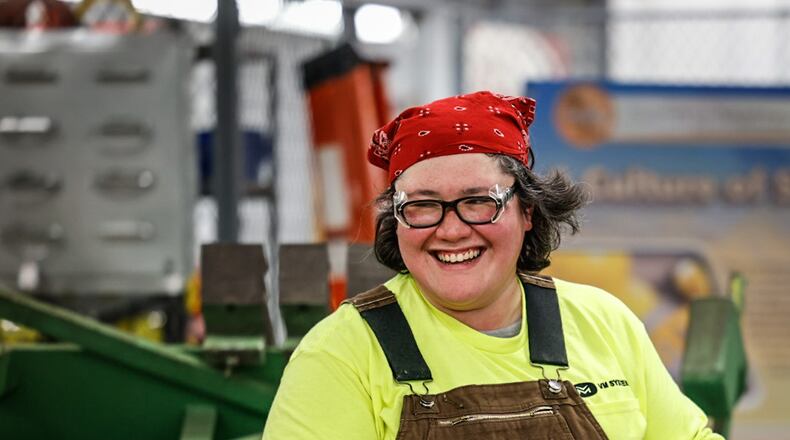“I found I am just not cut out for the office,” she said in an interview with the Dayton Daily News. “I am more of a builder. I like working with my hands. And I found I really like working with metal.”
Austin is a second-year sheet metal apprentice at Sheet Metal Workers Local 24 in Dayton, working for VM Systems, a ductwork contractor helping build a $390 million Royal Canin North America plant in Lewisburg.
Industry advocates believe Austin’s story exemplifies the opportunities available to apprentices willing to work for them.
The demand is there, especially with new construction across Southwestern Ohio. More than five million square feet of industrial space have been built around Dayton International Airport alone since 2014. Honda and Intel this year announced big Ohio construction projects of their own.
“The amount of work that is stacked up in the Miami Valley is out of control,” said Tony Stephens, apprenticeship coordinator at Local 24. “It seems like every week there is another $750 million ... project that gets announced. We are recruiting like mad.”
In all, Ohio has more than 21,000 apprentices in more than 180 occupations, with the Ohio Department of Job and Family Services ApprenticeOhio program ranking second in the nation in the number of apprentices, according to the state.
“Apprenticeship programs provide a smooth pathway to many manufacturing occupations,” ODJFS Director Matt Damschroder said in a recent statement.
And the opportunities go well beyond sheet metal. The following occupations have apprenticeship opportunities in Ohio: millwrights, structural iron and steel workers, electricians, glaziers, carpenters, brick masons and block masons, and plumbers, pipefitters, and steamfitters. (Programs and openings can be found at Apprentice.Ohio.gov.)
Nationally, more than 808,000 people work as apprentices in high-demand industries like health care, manufacturing, construction, transportation, energy and other fields, according to the U.S. Department of Labor.
Air Force vet’s story
Austin served in the Air Force in cyber-security and also worked as a journalist and photographer while in the service.
“I wanted a different kind of life,” she said. “I actually wanted a job where I could see the results of what I’m doing.”
Austin and her fellow workers install ductwork at the Royal Canin project, working with pieces varying from small size ductwork to 50-inch round to pieces twice as tall as a human being.
The life is rewarding but exacting. Her day starts early, at about 4:30 a.m. Work starts at 7 a.m. She could be putting duct up, assembling it or sealing it.
Two evenings a week, she also takes classes at the local on Poe Avenue.
“I’m always driving from Dayton to Hillsboro,” she said with a laugh. “A long drive, but well worth it.”
She has no complaints.
“It’s very rewarding,” said Stephens, who has 63 apprentices in Dayton. Being able to drive past a building or bridge and say, “I did that. See how tall that is? See how straight that is? I built that” is a feeling like no other, he said.
“There is a lot of pride in the building trades,” Stephens added.
No college debt
Ohio government said the state ranks first in the nation for plastics and rubber products manufacturing. It ranks second for primary metal manufacturing, machinery manufacturing, and electrical equipment, appliance, and component manufacturing. Manufacturing jobs in Ohio pay an average of nearly $67,000 a year.
The cost of the training is only a willingness to learn and work, Stephens said. Beyond that, sheet metal apprentices need to be at least 17, have a high school diploma or an equivalent, a driver’s license, reliable transportation and they must be able to pass drug tests.
“Everything else, we will teach you,” said Stephens. “Almost all the building trades programs have the same qualifications.”
His advice to those who think they may be interested: Do some research first. Find videos on YouTube about the daily work of electricians, plumbers or others in the building trades.
And be willing to show up every day. Of his apprentices who are fired, most often it’s because they failed to show up to job sites, he said.
Interest in apprenticeships has been steadily growing over the past decade, with similar growth in the number of apprenticeships and apprenticeship expansion grants, said Annelies Goger, a researcher at the Brookings Institution.
As an apprentice, Austin makes $18.13 an hour. That wage will surely rise if she continues in the field. And she can look forward to a future of no college debt.
“Hopefully, I’ll get to teach some apprentices of my own,” she said.
About the Author


